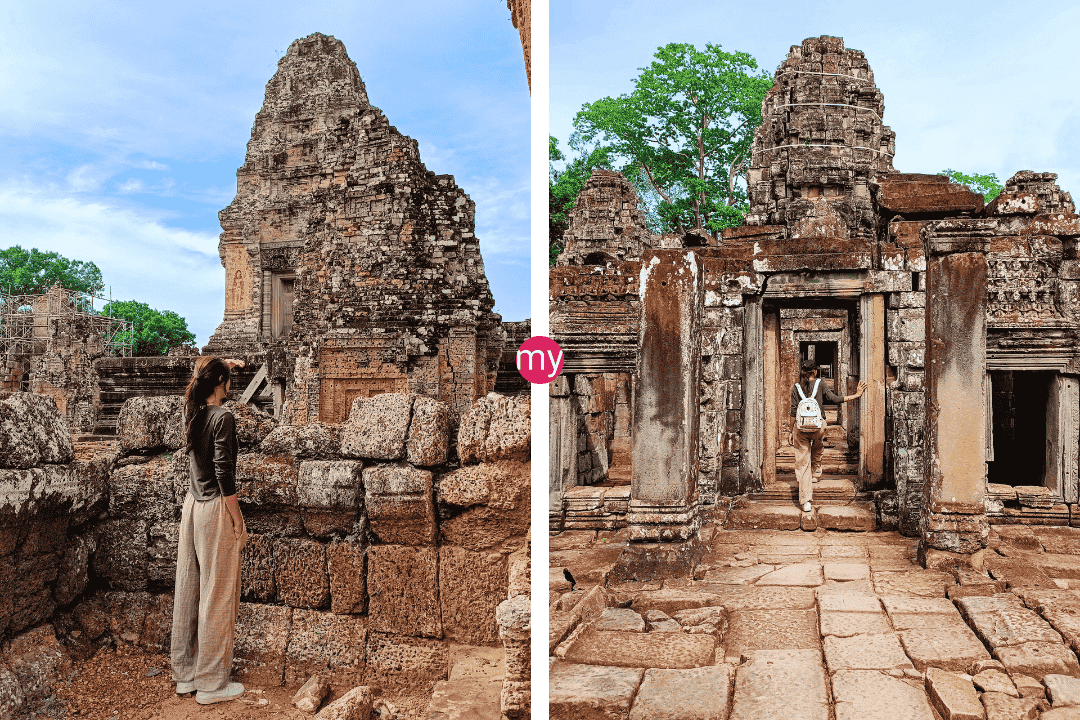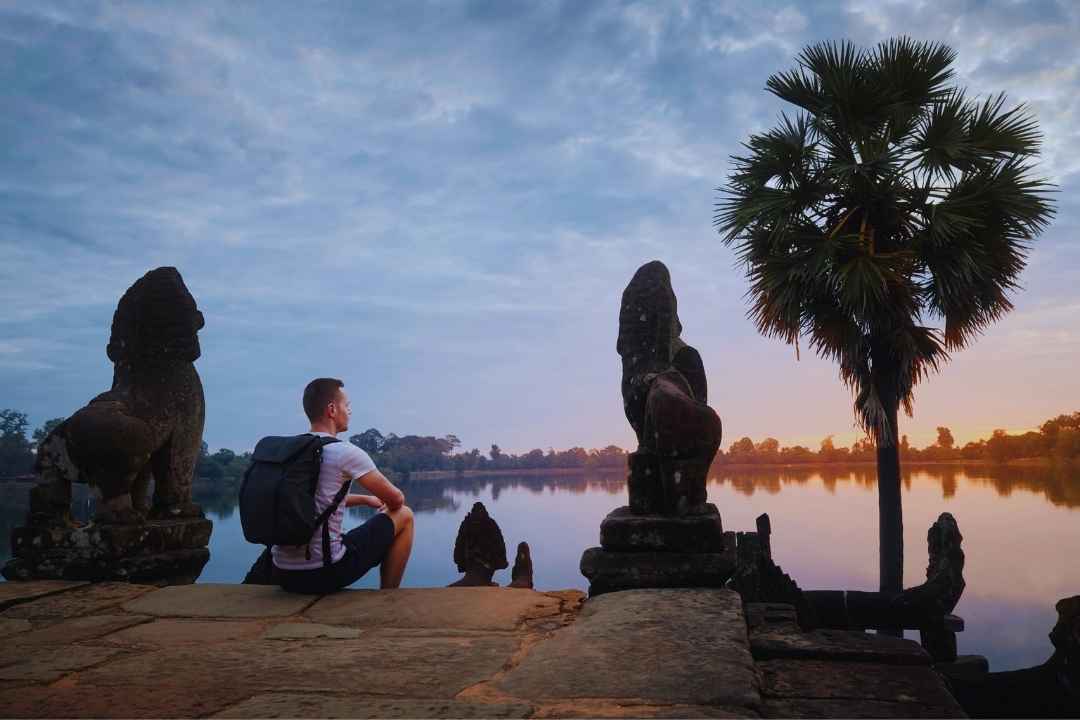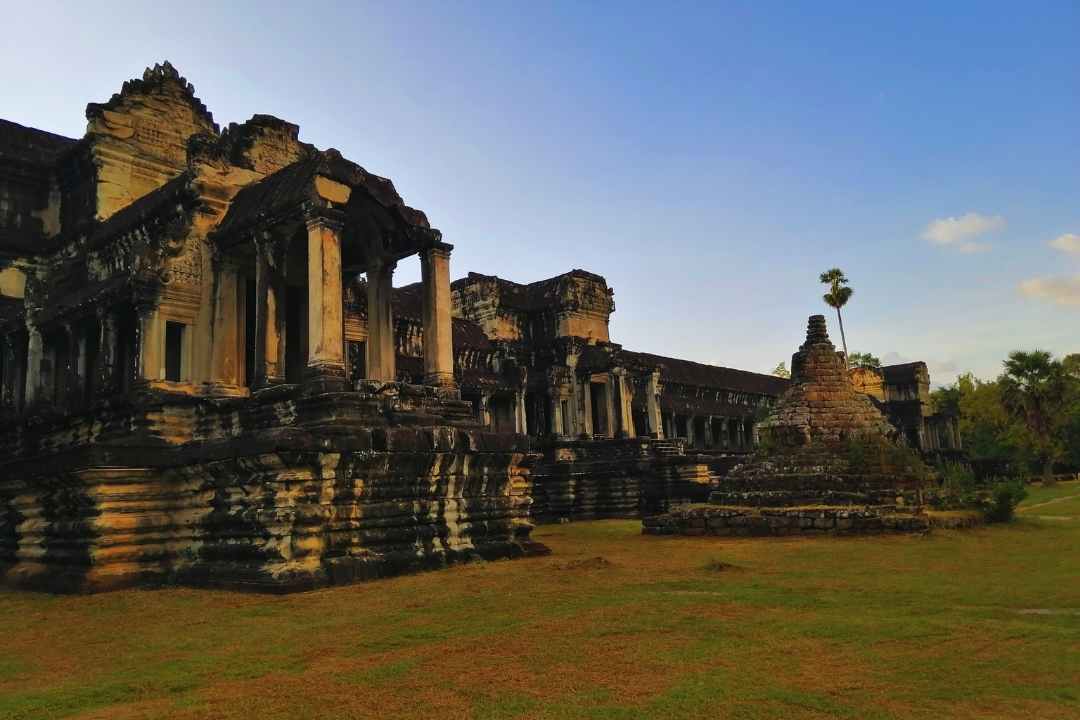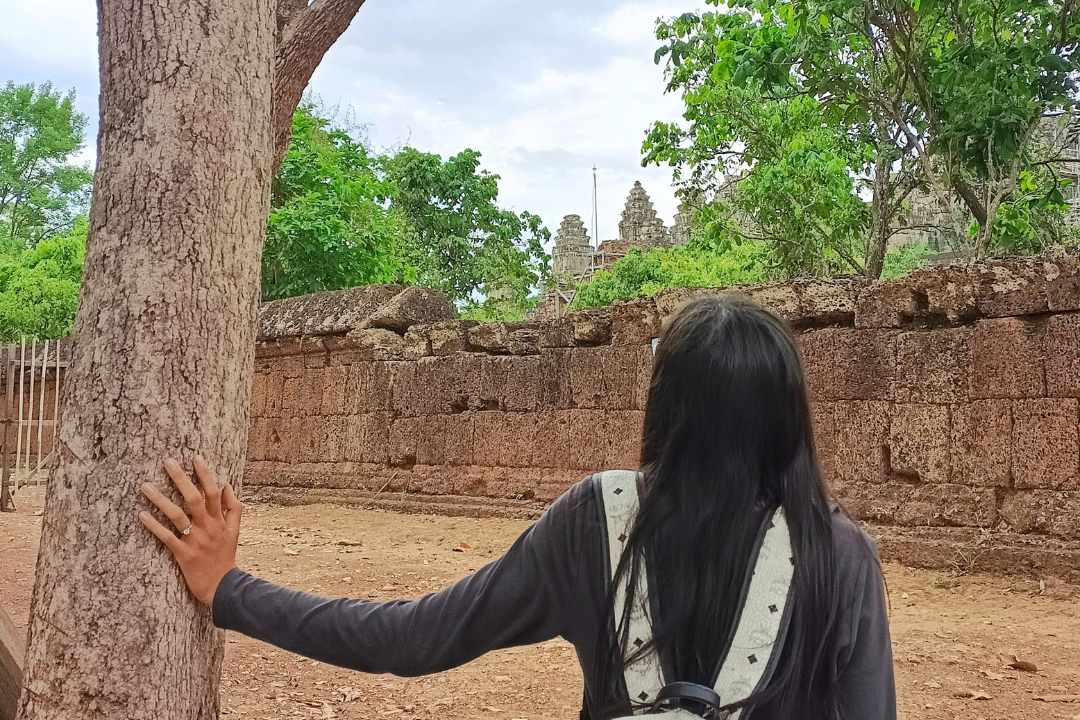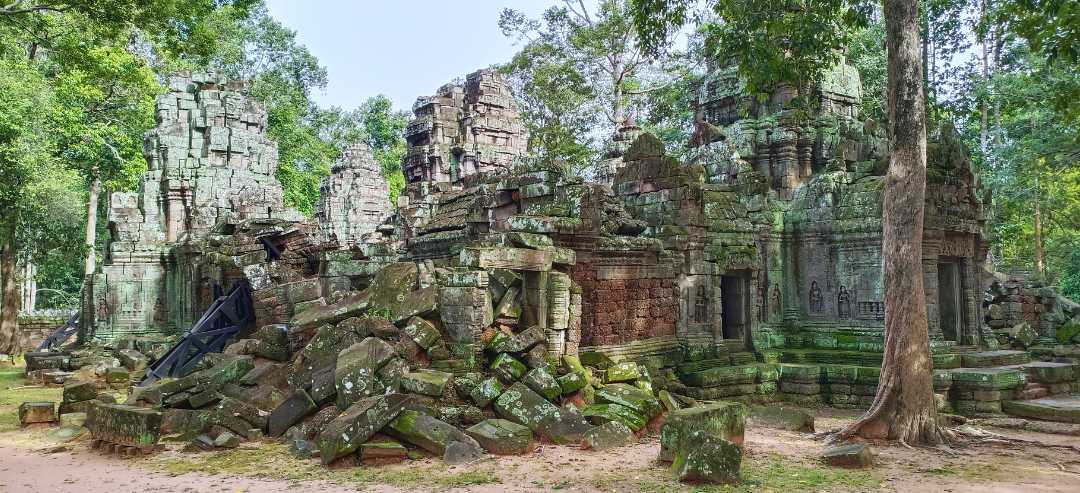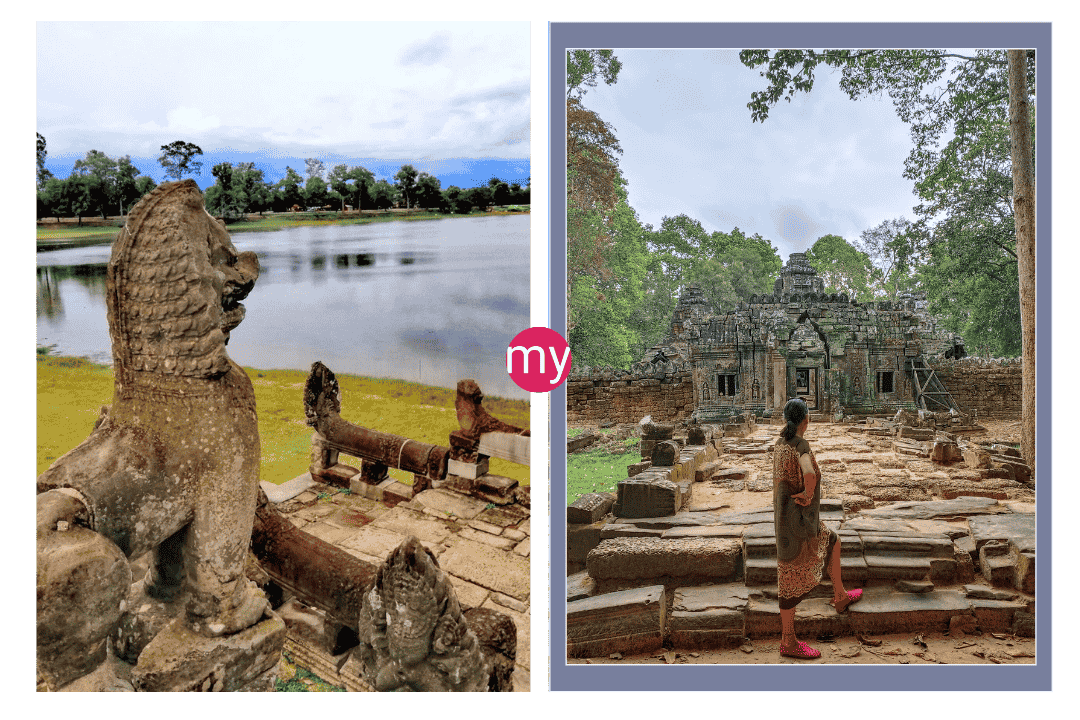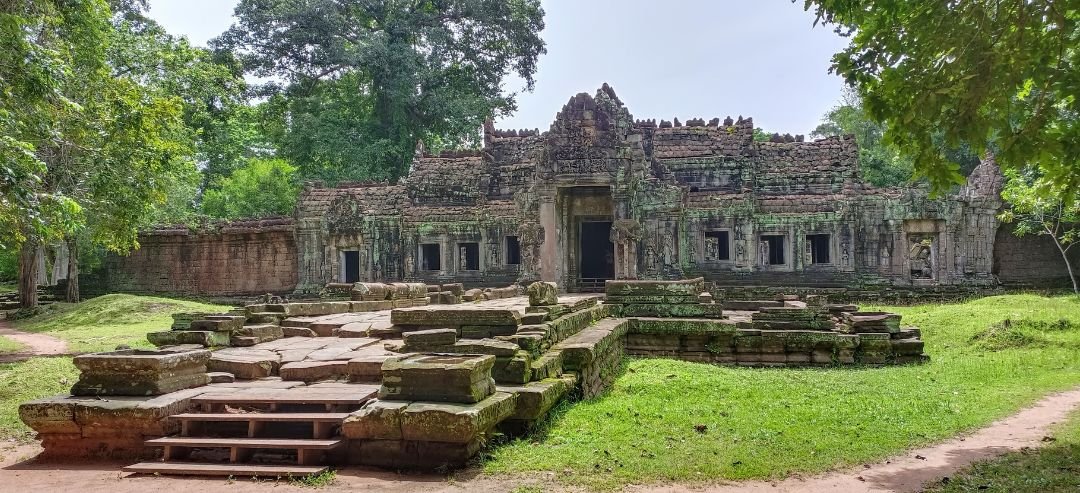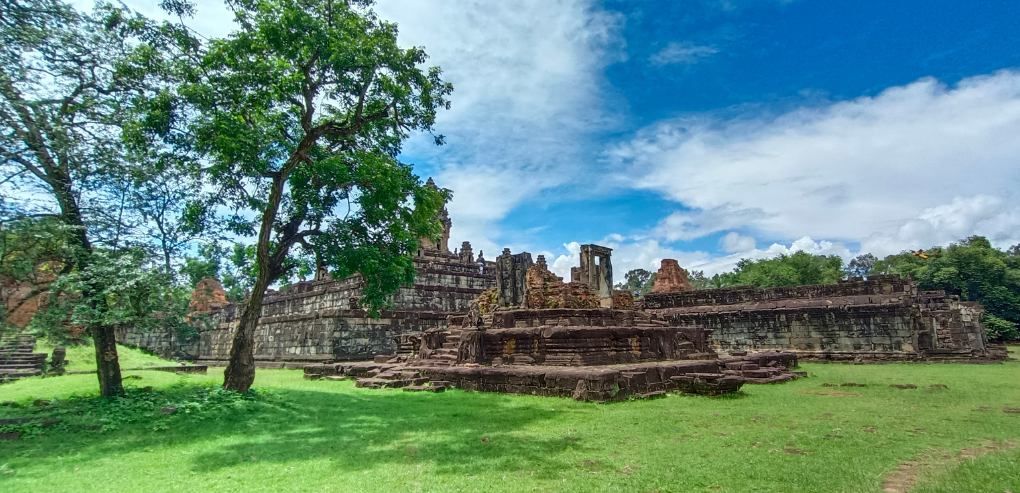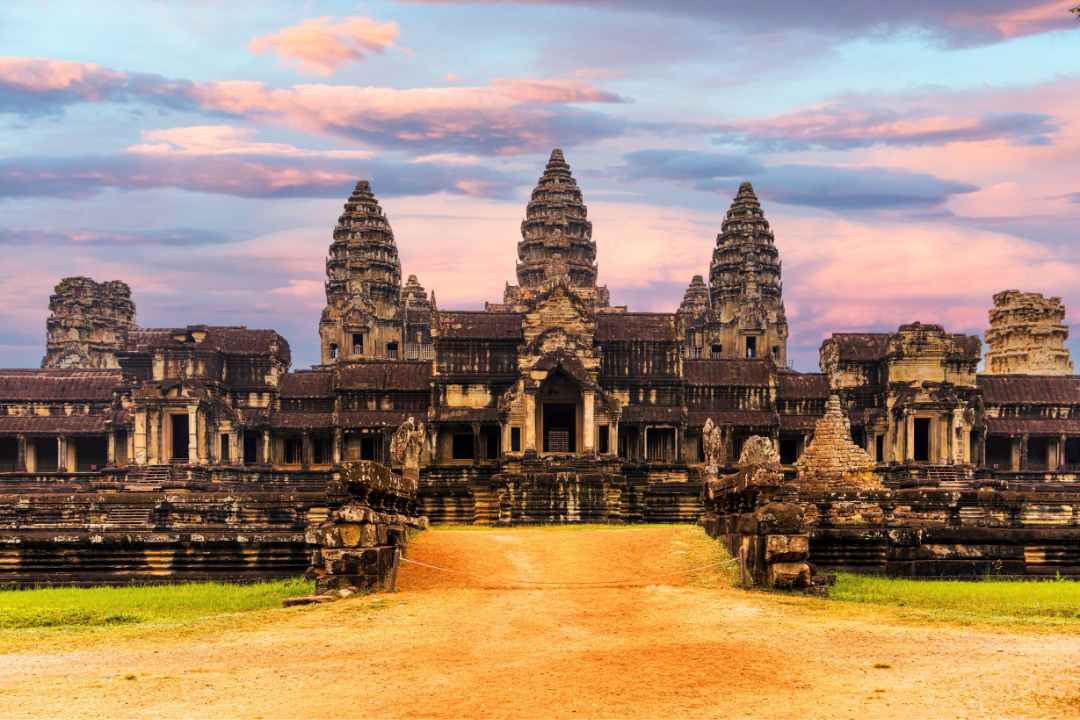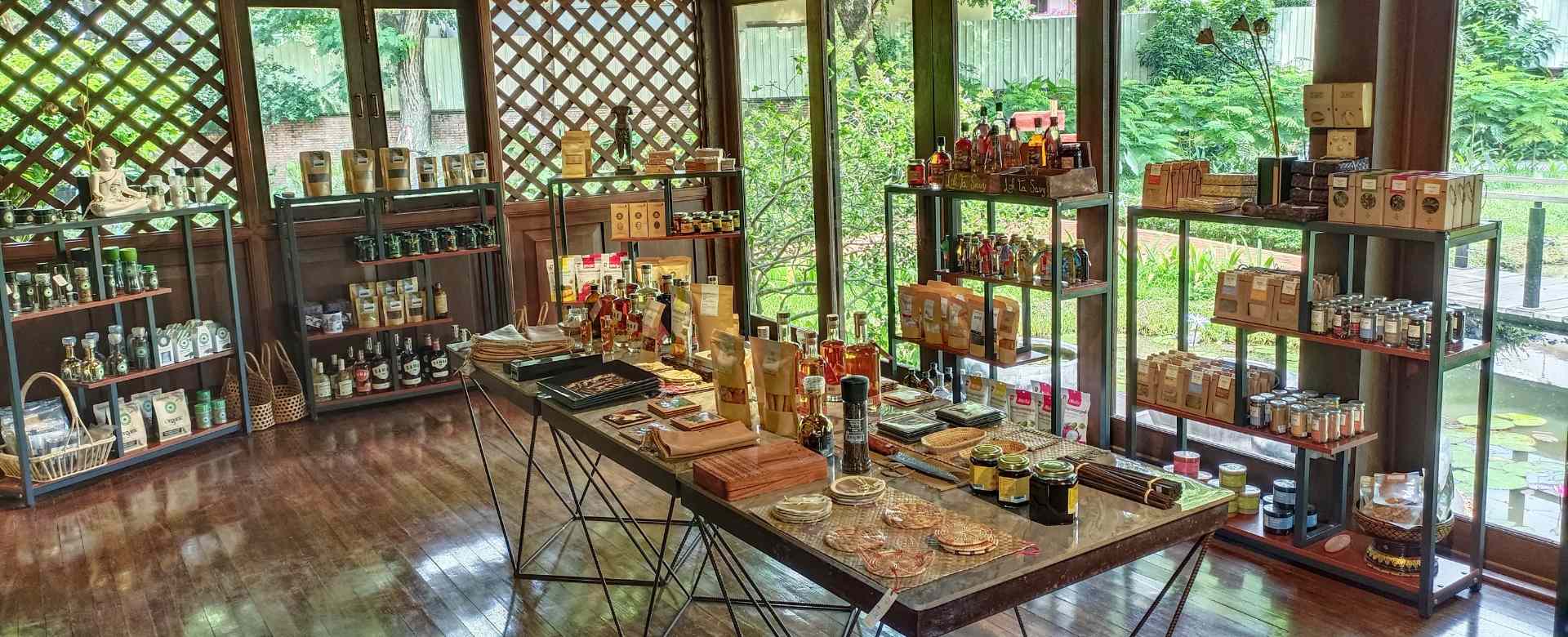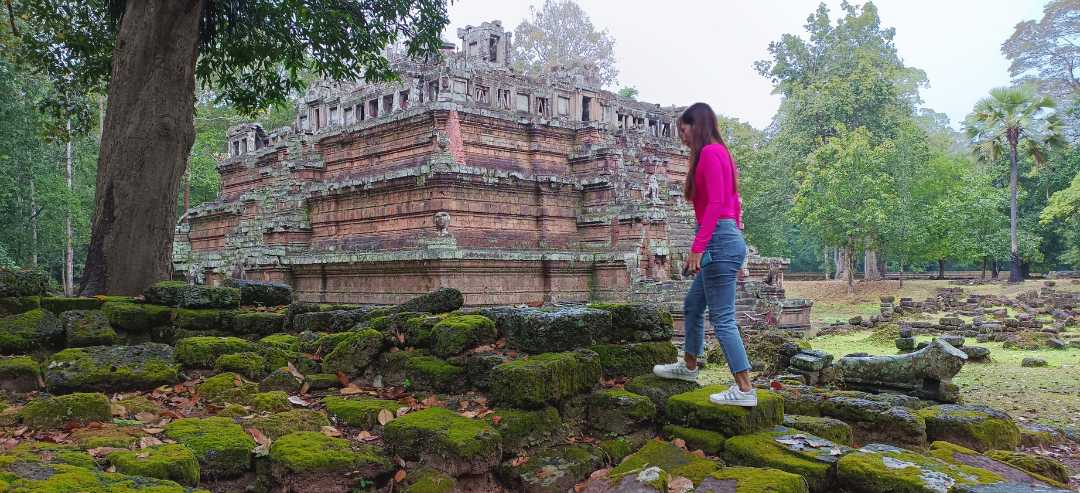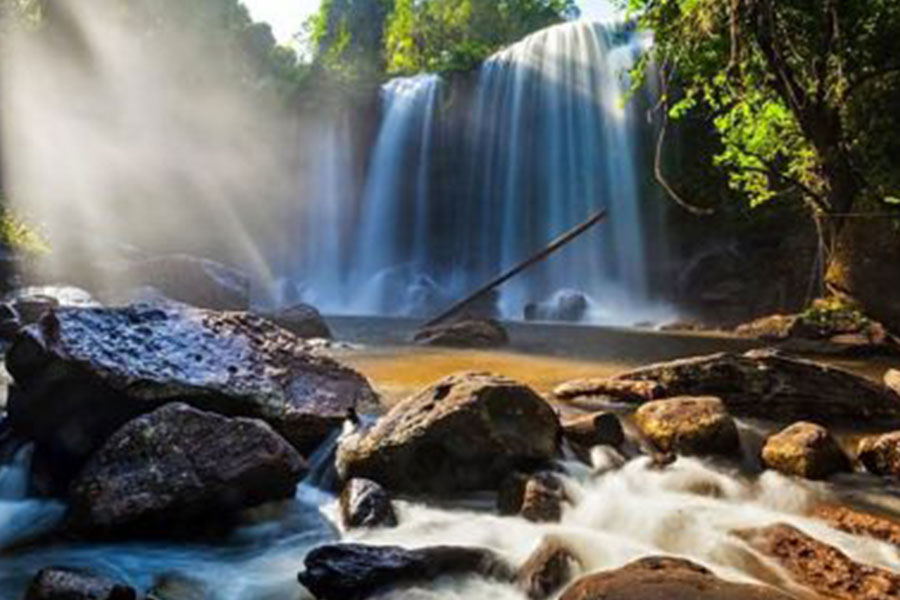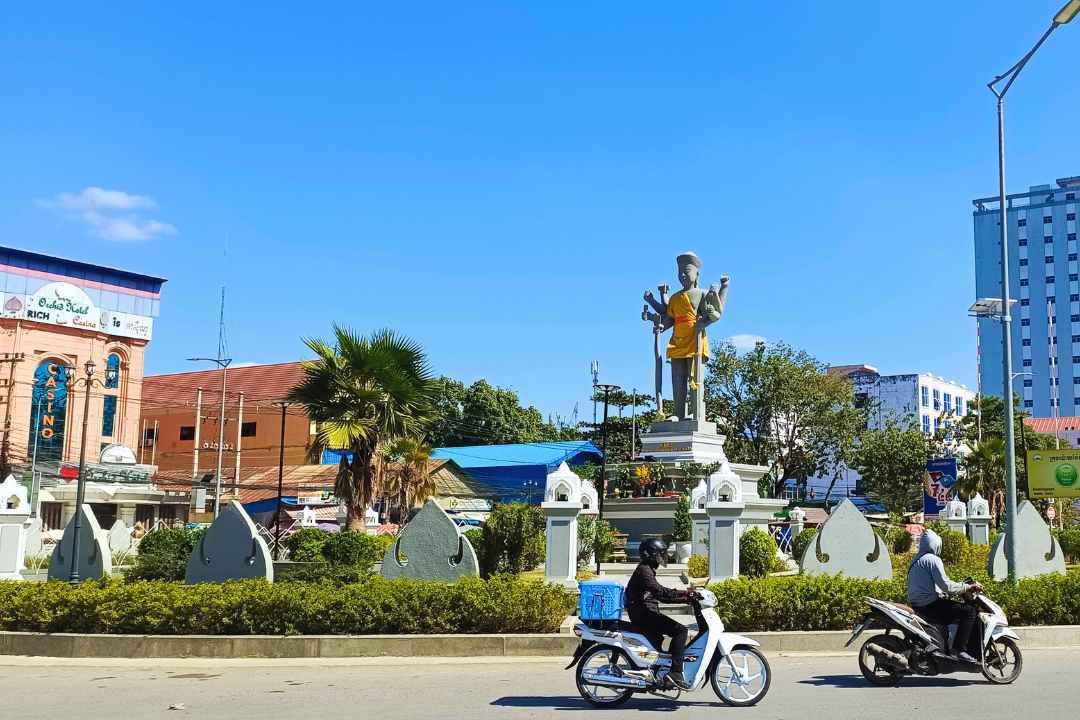Ta Prohm Temple in Cambodia - A Deep Dive into the Jungle Temple Ta Prohm
The Ancient Jungle Temple That Time Forgot - Your Complete Guide to Ta Prohm Temple in Cambodia
Ta Prohm Temple in Cambodia stands as one of the most magical places in Southeast Asia. The sight of massive tree roots hugging old stones creates a scene straight from a fairytale.
Ta Prohm Temple in Cambodia gives visitors a chance to see how nature and human works can blend in stunning ways.

Ta Prohm Temple in Cambodia: The Complete 2025 Visitor Guide | Ancient Jungle Temple
What Makes Ta Prohm Temple in Cambodia Special
- Historical Value: King Jayavarman VII built Ta Prohm Temple in Cambodia in 1186 CE as a Buddhist monastery for his mother. The temple once had almost 80,000 people working there, including priests, officials, and dancers. This shows how big and important the Khmer Empire was long ago. The temple’s first name was “Rajavihara,” which means “Royal Monastery” in Sanskrit.
- Trees and Temple Together: What makes Ta Prohm Temple in Cambodia different from other temples is how it sits with the jungle around it. When fixing up Angkor temples, workers cleared all plants. But at Ta Prohm, UNESCO and Cambodia chose to keep the huge silk-cotton trees and strangler fig trees growing on the buildings. These tree roots both hurt the temple and make it famous.
- Fixing While Keeping Wild Look: People working on Ta Prohm Temple in Cambodia have to be careful. They need to stop it from falling down while keeping its wild, jungle look. In 2025, experts finished fixing the northern west part of the temple. They used science to make the temple stronger but still kept the cool tree roots that everyone loves.
- Lots of Visitors: In just the first three months of 2025, about 398,531 foreign tourists came to Angkor Park where Ta Prohm Temple in Cambodia sits. Most guides say to visit early morning (before 9 AM) or late afternoon (after 2 PM) to avoid crowds and get the best light for photos. During these three months, the park made about $18.72 million, which shows how important these temples are for Cambodia’s money.
- New Findings: In 2025, people digging at Ta Prohm Temple in Cambodia found something cool – a Buddha statue with an unusual left hand gesture. The statue’s head was found almost 100 years ago in 1927! This find helps experts learn more about Buddhist art and religious customs in old Cambodia.
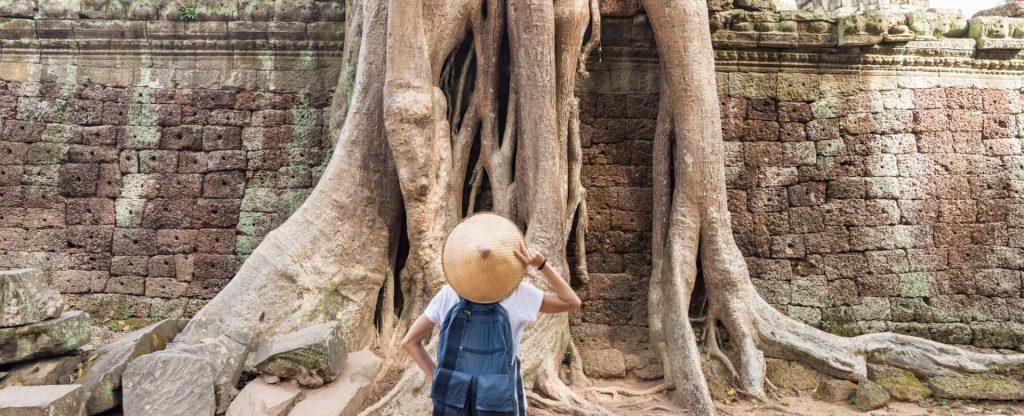
The Story Behind Ta Prohm Temple in Cambodia
How It All Started
Ta Prohm Temple in Cambodia was built when the Khmer Empire was at its peak. King Jayavarman VII, who ruled from 1181-1219 CE, loved making temples. Writing found at the temple says building started in 1186 CE. The king made this temple for his mother, who was shown there as a Buddhist wisdom goddess named Prajnaparamita.
While older Khmer temples were Hindu, Ta Prohm Temple in Cambodia was Buddhist. This shows a big change in what the empire believed. The temple worked as both a monastery and a school, with thousands of people living there.
Old writing says the temple once had:
- 3,140 villages
- 79,365 people taking care of it
- 5 tons of gold dishes
- 35 diamonds
- 40,620 pearls
- 4,540 gems
- 876 veils from China
- 512 silk beds
These riches helped support many religious workers, showing how rich and well-run the Khmer Empire was at its best.
How It Was Built
Ta Prohm Temple in Cambodia has a flat design, not a pyramid shape like earlier Khmer temples. Its layout includes:
- A big outer wall about 1000 by 600 meters
- Five walls inside each other
- A middle part for the main god
- Many galleries, libraries, and smaller shrines
| Architectural Feature | Description |
|---|---|
| Style | Bayon style (Late 12th-Early 13th century) |
| Layout Type | Flat temple design with east-west orientation |
| Construction Material | Sandstone and laterite |
| Notable Elements | “Hall of Dancers” featuring apsara carvings |
| Unique Features | Integration with massive tree roots |
The temple faces east like most Khmer buildings, with entrance gates at north, south, east, and west points. The whole place covers about 600,000 square meters, showing how big Khmer builders dreamed.
Left Alone and Found Again
After the Khmer Empire got weak and moved its capital from Angkor in the 1400s, Ta Prohm Temple in Cambodia was left empty. For hundreds of years, the jungle grew over the buildings.
French explorers found the temple again in the late 1800s. Henri Mouhot wrote about the Angkor temples, and Western people got very interested in these jungle ruins. Unlike other temples that got fully fixed up, French experts and later teams chose to leave Ta Prohm Temple in Cambodia partly covered by jungle, keeping the magical, mysterious feeling that first explorers loved.
Editor’s Note: Important Trends in 2025
Visitor data for Ta Prohm Temple in Cambodia shows several key trends in 2025:
- More Visitors: 14.6% more visitors compared to early 2024, with 398,531 foreign tourists visiting the wider Angkor Park.
- More Money: 13.2% more ticket money, making $18.72 million in early 2025.
- Visitor Changes: Shifting visitor types with big increases in tourists from:
- China (+24% compared to 2024)
- Southeast Asian countries (+19%)
- North America (+8%)
- Europe (+12%)
- Season Changes: Peak visiting times now go beyond the usual high season (November-February), with more visitors in March-May and August-October, showing a more even spread throughout the year.
- Online Talk: 35% more social media mentions and photo sharing of Ta Prohm Temple in Cambodia across platforms, especially Instagram and TikTok.
These trends show growing global interest in Ta Prohm Temple in Cambodia and good tourism growth plans by Cambodian officials.
Ta Prohm Temple in Cambodia Today in 2025
Recent Fix-Up Work
Keeping Ta Prohm Temple in Cambodia in good shape is hard: experts must save both the old buildings and the famous trees that might hurt them. In 2025, these big projects are happening:
- Northern West Part: A team from India led by Chitranjan Kumar is now in the third part of fixing this section. They’re making structures stronger while keeping the cool tree-temple look that everyone loves.
- Southern Gate Fix: Started in late 2023, this work is almost done in 2025. Workers are fixing a 20-meter-long gate that many visitors use to enter the temple.
- Tree Care Program: Working with tree experts, teams have started special care for 131 important trees growing on the temple. They trim dangerous branches, treat rotting parts, and watch root systems using ground radar.
The APSARA group (Cambodia’s team for Angkor) and UNESCO use many kinds of experts. They try to keep the temple strong but still looking wild and cool, knowing that the tree-temple mix is why people love Ta Prohm Temple in Cambodia.
Better for Visitors
To make visits better while protecting the temple, several new things started in 2025:
- New Paths: New raised wooden walkways lead visitors through the temple while causing less damage to fragile stone parts.
- Crowd Control: To stop too many people at famous photo spots, especially the “Tomb Raider tree,” visitors now get time slots during busy hours.
- Digital Info: QR codes let visitors get detailed history and building info in many languages.
- Watch Conservation Work: Special spots where visitors can see ongoing fix-up work and learn about conservation methods.
These changes help balance visitor access with keeping the temple safe, making sure Ta Prohm Temple in Cambodia stays a top cultural place while protecting it for future visitors.
New Findings
The ongoing work at Ta Prohm Temple in Cambodia keeps finding important things. The biggest find of 2025 was a Buddha statue body with an unusual left hand gesture found during digging in March. This body matched a head found in 1927, bringing together pieces that were apart for almost 100 years. Experts say the hand placement is very rare in Khmer Buddhist art, giving new info about art and religious practices back then.
Other findings include:
- Over 100 statue pieces found during southern gate digging
- Old drainage systems showing advanced Khmer water engineering
- Proof of living areas inside the temple walls, changing what we thought about how temples were used
These finds keep adding to what we know about Ta Prohm Temple in Cambodia‘s history and cultural importance.
Numbers and Facts About Ta Prohm Temple in Cambodia
Key Numbers and Why They Matter
Ta Prohm Temple in Cambodia makes up a big part of Angkor Park’s tourism draw and conservation focus. Key numbers include:
| Metric | Value | Significance |
|---|---|---|
| Annual Visitors (2024) | ~1.2 million | Demonstrates high tourist interest and potential conservation challenges |
| Conservation Budget (2025) | $4.3 million | Reflects significant investment in preservation |
| Temple Complex Size | 600,000 sq meters | Highlights the extensive scale of the site |
| Significant Trees | 131 documented specimens | Shows the scale of natural integration with architecture |
| Average Visit Duration | 1.5 hours | Indicates depth of visitor engagement |
| Restoration Completion | 62% of planned work | Shows progress in conservation efforts |
These numbers show the big resources used for keeping Ta Prohm Temple in Cambodia in good shape and how important it is for Cambodia’s cultural sites.
Comparing with Other Angkor Temples
When compared to other main temples in Angkor Park, Ta Prohm Temple in Cambodia shows different patterns in visitor likes and conservation problems:
| Temple | Daily Visitors (2025) | Tree Integration | Restoration Status | Visitor Satisfaction |
|---|---|---|---|---|
| Ta Prohm | 3,200 | High (131 trees) | 62% complete | 92% positive |
| Angkor Wat | 5,800 | Low | 89% complete | 95% positive |
| Bayon | 2,900 | Medium | 75% complete | 89% positive |
| Banteay Srei | 1,700 | Low | 92% complete | 87% positive |
| Preah Khan | 1,100 | Medium-High | 58% complete | 88% positive |
Ta Prohm Temple in Cambodia ranks second in visitor numbers but first in the problems caused by tree-structure mix, creating unique conservation needs. Its visitor happiness ratings stay very high despite ongoing fix-up work, showing good visitor management.
Comparing with Banteay Kdei and Ta Keo Temples
Ta Prohm Temple in Cambodia, Banteay Kdei, and Ta Keo are often compared because they’re close to each other and have historical links, but they show big differences in building style, conservation approach, and visitor experience:
| Feature | Ta Prohm Temple | Banteay Kdei | Ta Keo |
|---|---|---|---|
| Construction Period | 1186 CE | 1180 CE | Late 10th-Early 11th century |
| Builder | Jayavarman VII | Jayavarman VII | Jayavarman V |
| Primary Material | Sandstone | Sandstone & Laterite | Green Sandstone |
| Religious Affiliation | Mahayana Buddhist | Mahayana Buddhist | Hindu |
| Conservation Approach | Minimal intervention | Partial reconstruction | Extensive restoration |
| Tree Integration | Extensive | Moderate | Minimal |
| Visitors (2025) | 1.2 million/year | 450,000/year | 380,000/year |
While Banteay Kdei shares Ta Prohm Temple in Cambodia‘s Bayon architectural style and was built by the same king, it has had more extensive fix-up with less tree mix. Ta Keo represents an earlier architectural phase with a temple-mountain design and has been fully restored through a China-Cambodia team effort.
Detailed Tour Examples Featuring Ta Prohm Temple in Cambodia
Tour Example 1: Private Angkor Wat Sunrise Tour
This half-day guided experience shows Ta Prohm Temple in Cambodia as a highlight after the famous Angkor Wat sunrise viewing. The tour actively promotes the peaceful early morning feel at Ta Prohm, letting visitors see the temple before crowds arrive.
Main Features:
- Early access to Ta Prohm (around 8:30-9:30 AM)
- Professional guide explaining Buddhist symbols and historical importance
- Smart timing to catch best morning light coming through tree tops
- Special photo chances at less-visited parts
What Visitors Say: Guests always rate their Ta Prohm experience highly, noting the “magical atmosphere” and “amazing photo chances” when visiting in early morning. The tour keeps a 4.9/5 rating with special praise for the guide’s knowledge about the temple’s history and building style.
What This Shows: This tour proves how smart timing can really improve visitor experience at Ta Prohm Temple in Cambodia while reducing pressure on the site during busy hours. The focus on quality information makes visitors appreciate the site’s cultural importance beyond just its looks.
Tour Example 2: Half Day Early Morning Ta Prohm Tour with Ta Keo Temple
This special tour makes Ta Prohm Temple in Cambodia the main focus, starting at the temple’s opening time (6:20 AM) to give a full experience without crowds.
Main Features:
- Full 1.5 hours at Ta Prohm during best morning light
- Comparison with Ta Keo Temple, showing architectural differences
- Expert help on photo chances, including the famous “Tomb Raider tree”
- Small group size (maximum 9 people) ensuring personal attention
What Visitors Say: Reviews specially mention the value of visiting Ta Prohm Temple in Cambodia at opening time, with comments pointing out the “magical experience of having parts of the temple almost to ourselves” and “perfect light for photos.”
What This Shows: This tour shows focused experience design, seeing Ta Prohm Temple in Cambodia‘s special appeal as worthy of dedicated attention rather than as one stop among many. The comparison with Ta Keo gives educational context about different architectural styles and fix-up approaches within Angkor.
Tour Example 3: Private Angkor Wat Sunset Tour
This full-day experience includes Ta Prohm Temple in Cambodia as a midday highlight, making it the atmospheric contrast to the grandeur of Angkor Wat and Bayon Temple.
Main Features:
- Extended 1.5-hour study of Ta Prohm
- Smart timing includes lunch near the temple entrance, letting visitors rest and then see the site when many tour groups have left
- Complete circuit of the temple with exit from the opposite entrance, ensuring full coverage
- Expert information focusing on the temple’s appearance in the Tomb Raider film and its cultural importance
What Visitors Say: While specific reviews aren’t provided, the tour description notes that visitors specially like taking photos at Ta Prohm Temple in Cambodia and “absorbing the unique energy that the temple has to offer.”
What This Shows: This tour effectively puts Ta Prohm Temple in Cambodia into a broader Angkor experience, using it as a compelling midpoint in the day’s journey. Entering and exiting through different gates maximizes exposure to the site’s varied features while managing visitor flow.
Tour Example 4: Private Ta Nei Temple Tour
This new tour pairs the famous Ta Prohm Temple in Cambodia with the lesser-known Ta Nei Temple, creating a great contrast between a heavily visited site and a secret gem.
Main Features:
- Afternoon visit to Ta Prohm (2:00 PM) after morning activities at Ta Nei and an adventure zipline experience
- Making Ta Prohm the climax experience in a day of Angkor study
- Focus on the dramatic tree roots and massive strangler fig trees that make the temple special
- Photo chances in afternoon light, which creates dramatic shadows through the ruins
What Visitors Say: The tour is described as providing “great photos, amazing stories, and memories that last forever,” though specific reviews aren’t provided.
What This Shows: This tour effectively uses contrast to highlight what makes Ta Prohm Temple in Cambodia special, letting visitors appreciate both the less-visited quiet of Ta Nei and the dramatic, atmospheric quality of Ta Prohm. The scheduling shows how afternoon visits can be as good as morning visits, helping to spread visitor pressure throughout the day.
Tour Example 5: Exclusive Angkor Wat Tour Experience
This premium tour puts Ta Prohm Temple in Cambodia as a key attraction within a full Angkor experience, giving substantial time for study and information.
Main Features:
- Smart timing with lunch at Ta Prohm entrance followed by temple study
- Full circuit ensuring visitors see all major features of the temple
- Expert information connecting Ta Prohm to the broader context of Jayavarman VII’s building program
- Premium experience with fewer visitors per guide than standard tours
What Visitors Say: The tour emphasizes “unforgettable memories” and a “personal, unhurried experience,” suggesting high levels of visitor happiness with the Ta Prohm portion of the itinerary.
What This Shows: This case proves how Ta Prohm Temple in Cambodia can be effectively put into a premium tour product, with enough time and expert information justifying higher pricing. The positioning of Ta Prohm between Banteay Srei and Angkor Wat creates a narrative arc from intricate carving to nature-temple mix to monumental grandeur.
Future Outlook for Ta Prohm Temple in Cambodia
New Conservation Methods
The future of Ta Prohm Temple in Cambodia will likely see more complex conservation techniques that balance preservation needs with the site’s unique look. Coming trends include:
- Advanced Tree Monitoring: Using AI-powered systems to track health and growth patterns of important trees, predicting possible structural impacts before they happen.
- Better Supports: Developing less obvious support systems using advanced materials that give structural stability without ruining the temple’s atmospheric quality.
- Stop Problems Before They Start: Shifting focus from fixing damage to stopping damage causes, including water management systems and climate controls.
- Digital Twin Technology: Creating full digital models mixing architectural, botanical, and visitor data to simulate impacts of different conservation approaches before doing them.
These approaches reflect the changing understanding that Ta Prohm Temple in Cambodia‘s conservation needs teamwork between archaeologists, architects, botanists, and engineers.
Tourism Growth Plans
Cambodia’s “Sacred Tourism 2025-2035” policy has big implications for Ta Prohm Temple in Cambodia. Key projections include:
- Visitor Numbers: Expected growth to 1.5-1.8 million yearly visitors by 2030, needing better visitor management systems.
- Experience Variety: Creating specialized experiences including early-access photography tours, architectural study programs, and conservation-focused educational visits.
- Digital Growth: Expanding augmented reality apps letting visitors see the temple at different historical periods and understand conservation challenges.
- Time-Based Tickets: Starting dedicated time slots for Ta Prohm visits to manage carrying capacity and improve visitor experience.
- Cultural Programs: Adding cultural performances and meditation sessions in appropriate temple spaces, connecting visitors with the site’s spiritual meaning.
These changes aim to make visitor experiences better while managing impacts on the site’s physical structure.
Research Frontiers
Future research at Ta Prohm Temple in Cambodia is expected to focus on several promising areas:
- Living Archaeology: Expanded digging in the temple area to better understand the living patterns of the temple’s extensive community.
- Tree Studies: Research on the ecological dynamics of the temple environment, including the complex relationships between tree species, building materials, and local climate.
- Material Analysis: Advanced studies of original building materials and techniques to inform authentic restoration practices.
- Carving Research: Detailed documentation and analysis of remaining carvings and reliefs to rebuild the temple’s original decorative program.
- Historical Ecology: Reconstruction of the temple’s historical environment, including water management systems, gardens, and surrounding forest.
These research directions promise to deepen our understanding of Ta Prohm Temple in Cambodia beyond its visual appeal, showing its complex historical, religious, and social dimensions.
Practical Tips for Tourists Visiting Ta Prohm Temple in Cambodia
Best Ways to Visit
To see Ta Prohm Temple in Cambodia at its best, think about these tips:
- Timing: Visit either at opening time (6:00-7:00 AM) or in late afternoon (2:00-4:00 PM) to avoid peak crowds and enjoy best lighting conditions.
- Weather Tips: The dry season (November-April) offers more reliable conditions, though early wet season (May-June) provides lush greenery and fewer crowds. During wet season visits, morning hours are best due to afternoon rain patterns.
- Route Planning: Enter through the east gate (main entrance) but think about exiting through the west gate, seeing the temple against the typical flow of visitors.
- Photography Tips: Morning light best lights up the east-facing sections and famous “Tomb Raider tree,” while afternoon light creates dramatic shadows and lights up west-facing carvings.
- Time Needed: Allow at least 1.5 hours for study, though photography fans and history buffs may want to give 2-3 hours.
These tips will help visitors see the magical atmosphere of Ta Prohm Temple in Cambodia while avoiding the problems of overcrowding.
Ta Prohm Temple in Cambodia – Useful Visitor Information
| Category | Details |
|---|---|
| Opening Hours | 6:00 AM – 5:30 PM daily |
| Angkor Pass Required | 1-day ($37), 3-day ($62), 7-day ($72) |
| Dress Code | Shoulders and knees must be covered |
| Photography | Permitted throughout (tripods allowed with permit) |
| Guided Tours | Available in multiple languages |
| Accessibility | Limited for mobility-impaired visitors |
| Facilities | Restrooms and food vendors near east entrance |
| Wi-Fi | Limited connectivity within temple grounds |
Note that Ta Prohm Temple in Cambodia can be included in both the Small Circuit and Grand Circuit tour routes within Angkor Archaeological Park.
Cultural Manners at Ta Prohm Temple in Cambodia
When visiting Ta Prohm Temple in Cambodia, respecting these cultural norms makes your experience better and helps preservation efforts:
- Sacred Spaces: Though mostly a tourist attraction, Ta Prohm Temple in Cambodia remains a religious site for many Cambodians. Speak quietly near active shrines and never touch Buddha images.
- Physical Contact: Avoid touching carvings, structural elements, or tree roots, as oils from hands can speed up damage.
- Photography Ethics: Get permission before photographing monks or local worshippers. Avoid disruptive behaviors such as drone usage or blocking pathways for photos.
- Sustainable Tourism: Stay on marked paths to stop soil erosion and plant damage. Carry out all trash and think about contributing to conservation efforts.
- Local Engagement: Think about hiring a local certified guide who can provide cultural context while supporting the local economy.
Following these rules helps ensure Ta Prohm Temple in Cambodia stays preserved for future generations while showing respect for Cambodian cultural heritage.
Tips for Making the Most of Ta Prohm Temple in Cambodia
For Individual Visitors
- Learn Before You Go: Get familiar with Ta Prohm Temple in Cambodia‘s history and layout before arrival to appreciate subtle architectural details and religious symbolism.
- Smart Planning: Think about a two-visit approach—early morning for atmosphere and photography, followed by a guided afternoon visit for detailed historical context.
- Use Technology: Use available augmented reality apps or download temple maps that highlight key features often missed by casual visitors.
- Use All Your Senses: Take time to experience the temple beyond just looking—notice the sounds, smells, and atmosphere changes as you move through different spaces.
- Share Responsibly: Share your experiences on social media with accurate historical information, promoting deeper appreciation rather than just photo spots.
These tips will help change a visit to Ta Prohm Temple in Cambodia from a simple photo stop to a meaningful cultural experience.
Key Points About Ta Prohm Temple in Cambodia
- Building Marvel with Nature Mix: Ta Prohm Temple in Cambodia shows a unique fusion of human architectural success and nature’s power, where massive tree roots hug ancient stones in a captivating picture that draws photographers and travelers worldwide. This carefully preserved state makes it truly different from other Angkor temples, giving visitors a real glimpse of how these structures looked when first found again in the 1800s.
- Historical Importance in Khmer Buddhism: Built in 1186 CE by King Jayavarman VII and dedicated to his mother, Ta Prohm Temple in Cambodia worked as an important Mahayana Buddhist monastery and learning center. The temple supported an amazing 80,000 people including priests, officials, dancers, and workers, showing the huge resources and organizational ability of the Khmer Empire at its peak.
- Conservation Challenges and New Ideas: Saving Ta Prohm Temple in Cambodia creates unique conservation challenges that need balancing structural stability with keeping the temple’s distinctive atmosphere. Current restoration approaches use advanced technologies including ground-penetrating radar to watch root systems and targeted interventions that strengthen structures while keeping the temple’s romantic, partly ruined appearance.
- Best Visitor Experience During Early Morning or Late Afternoon: Tourism data and photography experts always suggest visiting Ta Prohm Temple in Cambodia either at opening time (6:00-7:00 AM) or in late afternoon (2:00-4:00 PM) to avoid crowds and see best lighting conditions. These times offer not only better photo chances but also a more quiet atmosphere that better shows the temple’s spiritual meaning.
- Money Maker for Cambodia’s Tourism: With Angkor Archaeological Park making $18.72 million in money during early 2025 alone, Ta Prohm Temple in Cambodia works as a key part of Cambodia’s tourism money. The site’s fame, helped by its appearance in films like Tomb Raider, has made it one of the most known archaeological sites globally and a main driver of international visits to Cambodia.
- Testing Ground for Heritage Management: Ta Prohm Temple in Cambodia works as a testing area for new ways to manage heritage that balance saving, tourism access, plant conservation, and cultural meaning. The lessons learned here change practices at similar sites worldwide, especially those facing the challenges of managing tree growth on archaeological structures.
- Ongoing Archaeological Finds: Recent digging at Ta Prohm Temple in Cambodia keeps yielding important finds, including the cool 2025 find of a Buddha statue body that matches a head found nearly a century earlier. These finds make our understanding of Khmer artistic traditions and religious practices better, showing the site’s continued research importance beyond its visual appeal.
Top Resources About Ta Prohm Temple
Want to dig deeper into Ta Prohm Temple in Cambodia? Check out these helpful links that will make your visit better and grow your knowledge:
- Latest Restoration Updates – See what parts of the temple are being fixed right now and how experts keep the trees safe while making the stones strong.
- The Temple’s Amazing Trees – Learn about the 131 special trees that grow on the temple and how experts take care of them.
- Recent Buddha Statue Find – Read about the exciting 2025 find where a Buddha statue part matched a head found almost 100 years ago!
- Angkor Park Visitor Numbers – Get the latest facts about how many people visit Ta Prohm and the whole Angkor area.
- UNESCO Conservation Status – Find out how this World Heritage site is being watched over and kept safe for future visitors.
The Magic of Ta Prohm Temple in Cambodia
When you stand among the stone hallways of Ta Prohm Temple in Cambodia, where huge tree roots hug ancient walls in a centuries-long dance, you feel something truly magical. This isn’t just another temple – it’s a perfect snapshot of time stopped, where nature and human creation have reached an unlikely balance.
What makes this place so special isn’t just its look in famous movies or its great photos – it’s the story it tells about change and strength. The stones may crack under growing roots, but somehow both tree and temple last, making something more beautiful together than either could alone.
If you plan your own trip to this amazing site, remember these simple steps:
- Visit early morning or late afternoon for the best time
- Get a guide who can tell the temple’s rich story
- Take time to walk beyond the main photo spots
- Try a special tour that focuses just on Ta Prohm
- Show respect for both the cultural meaning and fragile nature of the site
For a trip that perfectly mixes adventure, culture, and unforgettable memories, connect with our expert guides today.
Brought to you by Dan and Mat, Your tour planners.
Featured
Explore more on My Siem Reap Tours
Koh Ker and Beng Mealea guided tour | Banteay Srei temple guided tour | Angkor Wat Sunrise tour | Private Angkor Wat Sunset Tour | Koh Ker and Beng Mealea guided tour | Morning Siem Reap floating village tour | Afternoon Siem Reap floating village tour | Private Angkor Wat special tour | Kulen Waterfall small group guided Tour | Private Angkor Wat mix temples photo tour
